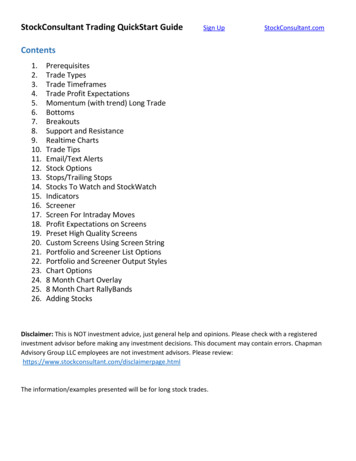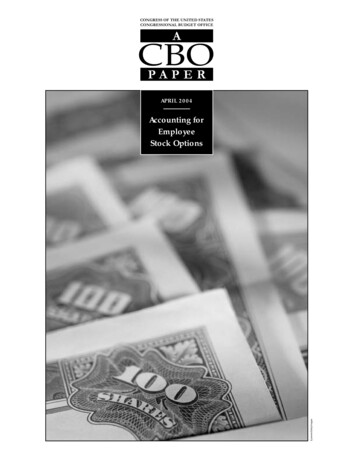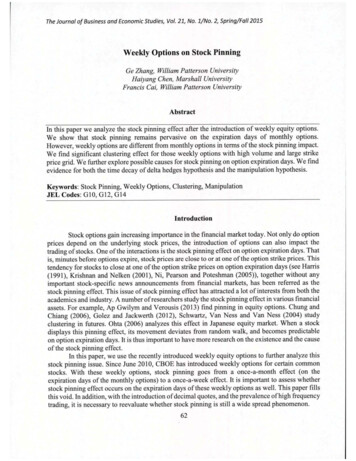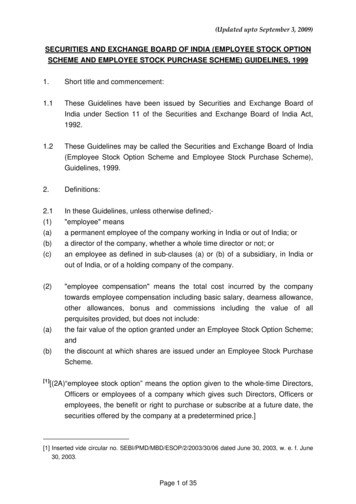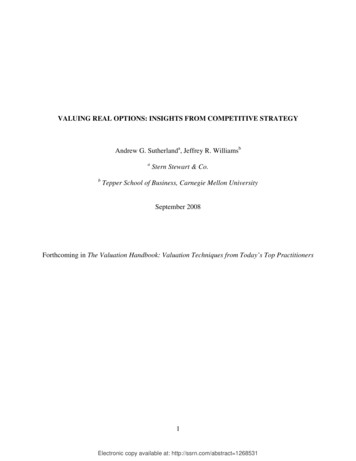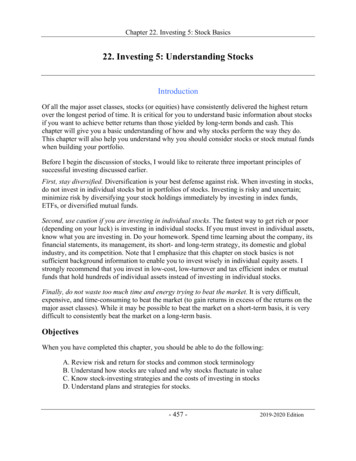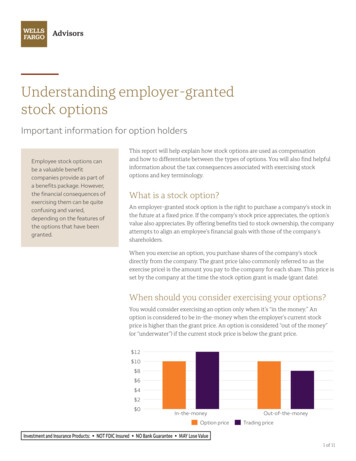
Transcription
Understanding employer-grantedstock optionsImportant information for option holdersEmployee stock options canbe a valuable benefitcompanies provide as part ofa benefits package. However,the financial consequences ofexercising them can be quiteconfusing and varied,depending on the features ofthe options that have beengranted.This report will help explain how stock options are used as compensationand how to differentiate between the types of options. You will also find helpfulinformation about the tax consequences associated with exercising stockoptions and key terminology.What is a stock option?An employer-granted stock option is the right to purchase a company’s stock inthe future at a fixed price. If the company’s stock price appreciates, the option’svalue also appreciates. By offering benefits tied to stock ownership, the companyattempts to align an employee’s financial goals with those of the company’sshareholders.When you exercise an option, you purchase shares of the company’s stockdirectly from the company. The grant price (also commonly referred to as theexercise price) is the amount you pay to the company for each share. This price isset by the company at the time the stock option grant is made (grant date).When should you consider exercising your options?You would consider exercising an option only when it’s “in the money.” Anoption is considered to be in-the-money when the employer’s current stockprice is higher than the grant price. An option is considered “out of the money”(or “underwater”) if the current stock price is below the grant price. 12 10 8 6 4 2 0In-the-moneyOption priceOut-of-the-moneyTrading priceInvestment and Insurance Products: NOT FDIC Insured NO Bank Guarantee MAY Lose Value1 of 11
Another factor that may significantly affect the timing of your option exercises isthe vesting schedule. Vesting refers to the date on which options can be exercised.By instituting a vesting schedule, an employer may require you to complete aperiod of service after the option has been granted before it can be exercised.As a result, vesting schedules help encourage continued employment.A vesting schedule may be graduated so that some percentage of the optionsbecomes exercisable at regular intervals over a certain period. For example,a common vesting schedule requires that employees wait one year from thegrant date before any of the options are exercisable. On the first anniversary ofthe grant date, 20% of the options can be exercised. Under this type of schedule,the remaining options will continue to vest at the rate of 20% per year for thenext four years until all of the options are fully vested.In contrast, another common cliff-vesting schedule provides that none of theoptions granted can be exercised within the first three years following thegrant date. On the third anniversary of the grant date, all of the options areimmediately available for exercise. While time-based vesting remains popular,companies are increasingly granting equity that vests upon meeting certainperformance criteria.Expiration dates refer to the end of an option’s life. Stock options are usuallygranted for a specific period (option term) and must be exercised within thatperiod. A common option term is 10 years, after which, the option expires.You should be alert to the terms of your stock option plan with respect to anychanges in these dates. For example, your company’s plan’s terms may dictatethat if you separate from employment, that separation will accelerate youroptions’ expiration date. It is common for plans to allow as little as 90 days toexercise any remaining options that have vested on or before the event date.These terms may treat different events in different ways. For example, a planmay provide different expiration dates if your separation is the result oftermination, retirement, disability, or death.Types of stock optionsStock options come in two forms: incentive stock options (ISOs) andnonqualified stock options (NSOs). The primary difference between the twotypes is how you will be taxed.ISOsThere are no tax consequences to you when you are granted ISOs because notransfer of any property occurs on the grant date. To qualify as an ISO, theoptions must have a grant price that is not less than the stock price on the grantdate and must have an option term of 10 years or less.When an ISO is exercised, the grant price becomes your cost basis for the sharesyou receive. When you eventually sell these shares, the difference between thestock’s selling price and your cost basis (typically grant price) is the income youmust consider for tax purposes. As discussed next, the timing of your sale ortransfer of these shares is critical for determining how you will be taxed.2 of 11
Although there is no taxable event created when you exercise ISOs, there stillare potential tax consequences. The difference between the stock price on theexercise date and your option cost represents the taxable spread. If you decide tokeep the shares that you receive from an ISO exercise, this taxable spread willbecome a preference item for alternative minimum tax (AMT) purposes for thecalendar year in which the exercise occurs.Special ISO-related issuesAlternative minimum tax (AMT)Although exercising an ISO does not result in immediate taxation, thetaxable spread is a preference item for the AMT. If you hold the ISO sharesbeyond December 31 of the year in which the option exercise occurs, thispreference item will be included as part of your AMT calculation for eachshare that you continue to hold. If you sell the shares in the next calendaryear, but before meeting the holding requirements, you can create ascenario in which the same taxable spread results in AMT liability in theyear of exercise and ordinary income in the next year.If you have large ISO grants, plan carefully so you can avoid stacking up toomany options to be exercised in any one year. Consult your tax advisor todetermine whether and how the AMT may affect you and to help you planISO exercises. Careful planning may help limit your AMT exposure. 100,000 ruleVesting schedules are particularly relevant with respect to ISO grants.When a company grants ISOs, the combined value of all shares that can beexercised for the first time (i.e., vested) in any one calendar year cannotexceed 100,000. The value is measured by the stock’s value on the grantdate. If the value of the vesting shares exceeds 100,000, the excessportion will be denied ISO treatment and will be taxed similarly to NSOs.When you sell stock received from ISO exercises, the timing of that sale becomescritical. As long as you have held the stock for the required holding period—at leastone year from the exercise date and two years from the grant date—the entiredifference between the stock’s selling price and your cost basis will be taxed as along-term capital gain. The greater the difference between the long-term capitalgains tax rate and your marginal tax rate, the more attractive an ISO becomes.If you don’t retain the stock for the required holding period (as defined above),you will not qualify for long-term capital gains tax treatment. This is referred toas a “disqualifying disposition.”If you “disqualify” your ISO shares, you will be taxed in a similar manner aswith NSOs, discussed next. The taxable spread created upon the exercise ofthe options (stock price minus the grant price) will be taxed as ordinary incomebased on marginal tax rates. If the stock has appreciated since the exercise date,that appreciation will be taxed as a short-term capital gain. The chart on thefollowing page contains a side-by-side comparison detailing the difference in taxtreatment for ISOs that satisfy the holding period and those that are sold in adisqualifying disposition.3 of 11
Typical tax treatment of an ISO¹ that has met therequired holding periodTypical tax treatment of the same ISO¹ in adisqualifying dispositionGrant date:June 15, 2018Grant date:June 15, 2018Number of options:1,000Number of options:1,000Grant price: 10Grant price: 10Stock price at exercise: 25Stock price at exercise: 25At exercise (June 15, 2021)At exercise (June 15, 2021)Payment to company:1,000 x 10 10,000Payment to company:1,000 x 10 10,000Shares to optionee:1,000Shares to optionee:1,000Cost basis: 10 per shareCost basis: 10 per shareTaxable spread:( 25 - 10) 15²Taxable spread:( 25 - 10) 15²Upon sale of shares occurring on or after June 16, 2022Upon sale of shares occurring on or before June 15, 2022Selling price: 35Selling price: 35Cost basis: 10Cost basis: 25⁴Long-term capital gain: 25³Ordinary income: 15 per shareShort-term capital gain: 10⁵Optionsgranted at 10/shareOptionsexercisedwhenmarketvalue is 25/shareCostbasis is 10/shareStocksold at 35/share;long-termcapitalgain of 25/shareOptionsgranted at 10/share 35 35 30 30 25 25 20 20 15 15 10 10 5 5 0June 15, 2018June 15, 2021After June 15, 2022 0Optionsexercisedwhenmarketvalue is 25/shareJune 15, 2018Costbasis is 10/shareOrdinaryincome is 15/shareStocksold at 35/share;short-termcapitalgain of 10/shareJune 15, 2021 Prior to June 15, 2022Another important feature associated with ISOs is the necessity of an ongoing relationship with the employer. If you havebeen granted ISOs and your employment is terminated, your ISOs will qualify for long-term capital gains tax treatmentfor 90 days following your separation date. After 90 days, your ISOs may expire, or they may be converted to NSO taxtreatment. Therefore, you should carefully review the terms in your option agreement and stock plan to determine how theoptions will be treated if you are terminated, voluntarily separate, retire, become disabled, or die.1. These hypothetical examples are designed to illustrate the effects of certain planning strategies based on stated assumptions. The strategies described may or may not be suitable for yourparticular situation. Before implementing any strategy, you should seek the advice of your tax and legal advisors. No guarantee of specific results is made.2. AMT preference item (per share)3. Because this sale occurred more than two years after the options were granted and one year and one day after the options were exercised, the holding period requirement was met. Therefore, thistransaction qualified for long-term capital gains treatment.4. Because both tests for meeting the holding period requirement have not been met, the ISO status is disqualified. When you sell, the stock price at exercise ( 25) becomes the cost basis because youare obligated to pay ordinary income tax based on the taxable spread on the date of exercise ( 15) and you have paid the grant price ( 10).5. Because you have not held the shares for at least one year and one day following exercise, the capital gain is a short-term capital gain, currently taxed at marginal tax rates.4 of 11
NSOsNSOs are the more common type of options companies grant. As with ISOs,no taxable event is created when NSOs are granted. Unlike ISOs, a taxable eventoccurs when you exercise NSOs. This taxation occurs whether you sell theresulting shares immediately or continue to hold them following exercise.When an NSO is exercised, you must recognize ordinary income equal to thetaxable spread (stock price on the date of exercise minus the grant price). Thisincome will be considered compensation income paid to you and will be includedon your Form W-2. This compensation will be subject to income taxes, as well aspayroll taxes.* (See “Planning for Withholding Taxes” on page 6.) Once NSOs areexercised, your cost basis for the shares will be equal to the stock price on theexercise date. If you elect to hold the shares following exercise, this cost basis willbe critical to computing your future gains or losses when you eventually disposeof the stock.When you sell the shares, you will recognize a capital gain or loss equal to thedifference between your cost basis (stock price at exercise) and the price at whichyou dispose of the shares. If you sell within one year of the exercise date, thecapital gain or loss will be short-term. If you sell the shares more than one yearafter the exercise date, a long-term capital gain or loss will result.Using the same facts as our ISO example on page 4 (1,000 options, 10 grantprice, 25 stock price on the date of exercise), when you exercise your NSOs,you would recognize 15 per share as ordinary income ( 15,000 total).Depending upon how long you hold the shares following exercise, you wouldrecognize a short-term or long-term capital gain on any selling price in excess of 25 per share (your cost basis).Typical NSO† tax treatmentOptionsgranted at 10/shareCost basisof 10/shareExercise at 25/share,ordinaryincome of 15/shareCostbasis is 25/shareStock sold at 35/share;long- orshort-termcapital gainof 10/share 35 30 25 20 15 10 5 0June 15, 2018June 15, 2021Sale*FICA (up to the FICA wage base) and Medicare† This hypothetical example is designed to illustrate the effects of certain planning strategies based on stated assumptions.The strategy described may or may not be suitable for your particular situation. Before implementing any strategy, you shouldseek the advice of your tax and legal advisors. No guarantee of specific results is made.5 of 11
Funding your stock option exerciseThe cashless stock optionexercise funding strategygenerally applies to publiclytraded companies wherethere is an available marketon a stock market exchange.You should consult with youremployer for private companyexercise alternatives.The simplest way for you to exercise your option is a cash exercise; i.e., yousimply write a check to the company for the purchase amount (grant price timesthe number of options being exercised) in addition to any applicable taxes.However, raising the cash to pay this purchase price can be difficult.If you don’t have available cash to fund your option exercises or don’t want touse your cash reserves to exercise your options, there are other strategies thatmay be available, depending upon your situation.‘Cashless’ stock option exercises are very popular. A cashless stock optionexercise lets you exercise your options without raising large amounts of cash ordisturbing your existing portfolio or cash reserves.Using a cashless stock option exercise, you can either sell all of the sharesimmediately or hold a portion for potential future appreciation. Once you havedetermined how many shares you want to sell, your Financial Advisor will placea trade to sell your shares in the open market even before the shares are deliveredby your company. When the order executes, Wells Fargo Advisors advances thenecessary funds to pay the exercise costs and any tax withholdings the companyrequires. We then work with your company to ensure that the shares aredelivered to Wells Fargo Advisors and the net shares or net proceeds will beavailable to you.Contact your Financial Advisor, who can help you take advantage of Wells FargoAdvisors’ Cashless Stock Option Exercise program. He or she will notify yourcompany of your intent to exercise through Wells Fargo Advisors and verify thatyour options are available and ready to be exercised.Planning for withholding taxesYour employer will report the ordinary income you must recognize in theyear you exercise your NSOs on your Form W-2. As with any othercompensation, your employer will generally withhold federal income tax(at the same rate as the taxation on bonus compensation — currently22%), employment taxes (Social Security and Medicare, which could be ashigh as 8.55% depending on other compensation paid to you), and anyother applicable state or local income tax. Most employers require you toremit any required tax withholding along with the amount you pay toexercise your option. Because this increases the cash you need, you shouldfactor withholding taxes into your cash planning. Be sure to consult yourtax advisor before exercising stock options to determine the additionaltaxes you may owe.A common variation of cashless stock option exercise is a strategy known as“sell to cover.” Using this strategy, your Financial Advisor will sell only thoseshares necessary to fund the exercise costs and taxes associated with exercisingthe amount of options you want to exercise. You continue to hold the optionshares in excess of those needed to pay the costs of the entire exercise. As aresult, the exercise is self-funded.6 of 11
A stock swap is another funding method. If your employer’s stock option plancontains a stock swap feature and you already own company stock, you may beallowed to trade your existing shares back to the company to pay the grant pricefor exercisable options. The stock price of the shares you surrender willdetermine how many options you can exercise. See the example below.Tax consequences of a stock swapPrior to transactionyou own:You swap toexercise:You receive:1,000 ISOs( 10 grant price)400 shares ABCvalued at 25/share( 100,000 total fairmarket value)Holding period for long-termcapital gains:400 shares with carryover basis 600 shares with nearly 0 cost basis(no tax at exercise)Begins anew for all1,000 shares400 shares with carryover basis 600 shares with basis equal tostock price (you must pay tax on 600shares at exercise or sell or surrenderadditional shares to settle taxes)400 shares retain originalholding period; 600 sharesbegin with new holding periodor1,000 NSOs( 10 grant price)In general, it is better to perform a stock swap with ISOs because of the taxtreatment afforded to you if you are able to hold the shares for more than oneyear following the swap. The advantage of a stock swap is that you avoid payingcapital gains tax on the shares you surrender. But you also need to realize that byswapping existing shares for option shares you will end up with fewer sharesthan if you simply purchase the options outright.In the example provided, you are swapping shares to exercise ISOs and yourholding period will begin anew on all 1,000 shares. Any disposition prior tothis date will result in a disqualifying disposition (for ISO shares). If you areswapping shares in an NSO exercise, the shares have different holding periods.Some of the shares will have a carryover holding period and others will have aholding period that commences after the swap. If you fail to meet the holdingperiod requirements, selling the shares will result in short-term capital gainstax treatment.The tax and company policy consequences of a stock swap can be complex.If you’re considering the stock swap strategy, you should consult with yourtax-advisor, as well as your company’s benefits consultant or counsel to ensurecompliance with company policies, which vary.Margin loans may also be available to fund your option exercises. Using thisstrategy, you borrow the necessary funds from Wells Fargo Advisors to cover theexercise costs and taxes associated with your investments. The shares receivedfrom the option exercise are then deposited into your Wells Fargo Advisorsaccount and serve as collateral for the outstanding loan until it is repaid. Theamount you can borrow is subject to regulation and is tied to the value of yourholdings in the account. Because of the risk, this should not be considered as along-term strategy and may not be suitable for all investors. In addition, youmust check your company trading policy to make sure a margin loan is allowed.7 of 11
Taxation and cost basis of stock options and SARsTaxationPurchase datefor tax purposesCost basisper shareNSOOrdinary incometax on gainExercise dateFair market valueat exerciseISON/A (AMTpreference item)Stock optionsExercise priceDisqualifyingdisposition:Exercise price ordinary incomeStock Appreciation RightsStock-Settled SARsOrdinary incometax on gainExercise dateExercise dateCash-Settled SARsOrdinary incometax on gainNANAUnderstanding Stock Appreciation Rights (SARs)SARs give you the ability to request the appreciation in the value of astock from the date of grant to the date you choose to exercise your SARs.This value is equal to the spread between the SAR’s grant price and theissuer’s stock price on the date of exercise.The proceeds from SAR exercises can be paid in cash or stock. The value(appreciation) created at exercise will be included as ordinary taxableincome on your W-2 and the taxes must be paid before the exercise issettled in cash or net shares. If the SARs are stock-settled, the stock priceon the date of exercise becomes the cost basis of the net shares received.As with any other compensation, your employer will generally withholdfederal income tax, employment taxes (Social Security and Medicare),and any other applicable state or local income tax.The strategies you would employ with a SAR are much like the strategiesyou would consider with an employer granted stock option. You wouldonly consider exercising a SAR when it’s “in-the-money,” which meansthe issuer’s current stock price is greater than the grant price of the SAR.Like an employer granted stock option, SARs have a grant price, vestingschedule and expiration date.Unlike an employer granted stock option, you need no up-front cash toexercise your SARs. You will receive the appreciated value of the SARabove the grant price at the time of exercise. To exercise your SAR, youwill need to notify your company of your desire to exercise in accordancewith the process outlined in your stock plan or agreement. Because noshares need to be sold into the market to exercise SARs, there is lessdilution to the company’s shareholders. For this reason, SARs maycontinue to be a preferred equity benefit by companies.8 of 11
Making the most of your stock option benefitBecause of the varying cash requirements and tax consequences associated withISOs and NSOs, carefully consider when you should exercise your options anddevelop an option exercise strategy that works for you. You should include yourFinancial Advisor with your team of legal and tax advisors to develop an exercisestrategy that furthers your overall financial plan.Combine your knowledge of your company, your Financial Advisor’s knowledgeof the market conditions, and any other factors that can affect your stock’strading patterns. Factor in your tax advisor’s evaluation of your tax situationand how exercising your options will affect your current and future tax liabilities.Once you’ve assessed these relevant factors, you can begin to meet your goalswith a well-planned exercise and/or sales strategy.GlossaryAlternative minimum tax (AMT): A special tax originally designed to helpensure that wealthy individuals couldn’t use certain strategies to avoid payingincome taxes. Today, more taxpayers find themselves subject to the AMT.Exercising ISOs can generate an AMT preference item equal to the differencebetween the option price and the stock’s value on the exercise date.Capital gain or loss: The difference between an employee’s cost basis and thestock’s market value on the day a security is sold. Capital gains (or losses) areshort-term if the employee holds the security for one year or less and long-termif he or she holds the security for more than one year.Cashless option exercise: A method of exercising stock options withoutrequiring the employee to make any initial cash outlay.Commission: The fee a financial institution charges for executing a transaction.Cost basis: For NSOs, the stock’s value on the exercise date. For ISOs, the grantprice paid when options are exercised (unless disqualified).Disqualifying disposition: The sale or other disposition of shares acquiredthrough an ISO exercise before satisfying the holding requirement.Exercise date: The date stock options are exercised to purchase stock at thegrant price.Exercise price: See “Grant Price.”Grant date: The date stock options are given to the recipient.Grant price: The price an employee must pay the company for shares purchasedwhen exercising options. The grant price is set on the grant date. Also referred toas the option price, exercise price or strike price.Incentive stock option (ISO): A type of stock option that qualifies for specialtax treatment. Exercising an ISO does not create taxable income; however,it may increase the possibility that the employee will be subject to the AMT.In-the-money: A phrase used to describe the value of stock options wheneverthe market price of the underlying stock rises above the grant price.9 of 11
You can count on usYour Financial Advisor willwork with you and your taxadvisor to create an exercisestrategy for your employergranted stock options.Margin loan: A loan that lets an individual purchase stock and borrow up tohalf its market value from a brokerage firm. Using this strategy comes withsubstantial risk and may not be allowed by the employer.Market price or value: The current stock price of a public company asdetermined by the stock market.Nonqualified stock option (NSO): A type of stock option that incurs ordinaryincome taxes at exercise, regardless of whether the shares are sold or held.Option price: See “Grant Price.”Out-of-the-money: A phrase used to describe the value of stock optionswhenever the market price of the underlying stock is below the grant price.Settlement date: The date by which either cash (for a buyer) or shares ofstock (for a seller) must be delivered to a brokerage firm to complete asecurities transaction.Spread: The difference between the grant price and the stock’s value on theexercise date.Stock option: A right a company issues that gives the recipient the ability topurchase a specific number of shares of company stock at a specified priceduring a specific period.Stock option agreement: A document that sets forth the terms of optionsissued to employees. It includes the type and number of options granted,vesting schedule, expiration date, and funding alternatives.Stock option financing: See “Cashless Option Exercise.”Stock swap: A feature that lets an option holder surrender shares of companystock he or she owns to cover the amount owed on the exercise date.Strike price: See “Grant Price.”Stock symbol: The unique identification symbol given to a corporation whosestock is traded on a stock exchange.Underwater options: See “Out of the Money.”Vesting: A schedule requiring that a certain time period elapse after the option isgranted before it can be exercised.Talk to Wells Fargo AdvisorsWe welcome the opportunity to work with you to help you achieve yourfinancial goals. Let us know if there are any other topics or services of interest toyou.
Margin borrowing may not be suitable for all investors. When you use margin, you are subject to ahigh degree of risk. Market conditions can magnify any potential for loss. The value of securities youhold in your account, which will fluctuate, must be maintained above a minimum value in order for theloan to remain in good standing. If it is not, you will be required to deposit additional securities and/orcash in the account or securities in the account may be sold. Clients are not entitled to choose whichsecurities in their accounts are sold. The sale of their pledged securities may cause clients to suffer taxconsequences. Clients should discuss the tax implications of pledging securities as collateral with theirtax advisors. An increase in interest rates will affect the overall cost of borrowing. Wells Fargo Advisorsand its affiliates are not tax or legal advisors. Margin strategies are not suitable for retirement accounts.Please carefully review the margin agreement, which explains the terms and conditions of the marginaccount, including how the loan is calculated.This publication is designed to provide accurate and authoritative information regarding the subjectmatter covered. It is made available with the understanding that Wells Fargo Advisors is not engaged inrendering legal, accounting or tax-preparation services. If tax or legal advice is required, the services of acompetent professional should be sought.Wells Fargo Advisors’ view is that investment decisions should be based on investment merit, not solelyon tax considerations. However, the effects of taxes are a critical factor in achieving a desired after-taxreturn on your investment.The information provided is based on internal and external sources that are considered reliable; however,the accuracy of the information is not guaranteed.Specific questions on taxes as they relate to your situation should be directed to your tax advisor.Wells Fargo Advisors is a trade name used by Wells Fargo Clearing Services, LLC and Wells Fargo Advisors Financial Network, LLC,Members SIPC, separate registered broker-dealers and non-bank affiliates of Wells Fargo & Company. 2012, 2014-2015, 2017-2021 Wells Fargo Clearing Services, LLC. CAR-0122-01369 IHA-7185634
An employer-granted stock option is the right to purchase a company's stock in the future at a fixed price. If the company's stock price appreciates, the option's value also appreciates. By offering benefits tied to stock ownership, the company attempts to align an employee's financial goals with those of the company's shareholders.



